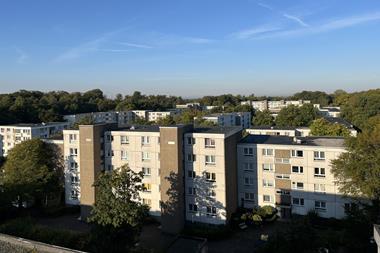Governments worldwide have followed the UK's lead in opting for private funding of public infrastructure. Christine Senior reports
Infrastructure investments have taken off in the past few years. The preference of governments to retreat from the ownership and management of infrastructure has coincided with increasing demand from such investors as pension funds and insurance companies for stable, cash flow yielding assets with long time horizons to match their liabilities. A signal that infrastructure investment has come of age was the launch of the Macquarie Global Infrastructure Index (MGII) in 2005.
The UK kicked off the trend for attracting private finance into public infrastructure projects 20 years ago when Margaret Thatcher's government sold off state-owned assets. Its success has been emulated in other parts of Europe, as governments face the same problems of funding gaps - they need to put investment into infrastructure projects but fear alienating their voters by raising taxes to fund them.
Lack of government funds might have been the primary driver for putting the financing and management of public infrastructure into private hands, but it has proved so successful a model that now even governments with no shortage of cash are adopting it.
Arthur Rakowski, executive director and head of the equity fund raising team at Macquarie, says private capital is valued not only for the cash input but also for the expertise and management discipline that it brings.
"If you look at the UK and the PPP/PFI market, the model has proved to be a highly efficient way of rolling out new infrastructure," he says. "Governments in places like the Middle East and Russia are also looking at PPP/PFI-type programmes to introduce private discipline into the process as well as international management skills and global best practice."
Privatisation in Europe is still gathering pace, and it will take time and will be subject to the vagaries of political manoeuvrings, opposition from vested interests and a tangled bureaucracy. One recent high-profile manifestation of government interference in utilities was the well-publicised intervention of the French president, Nicolas Sarkozy, in the merger of electricity and environmental services firm Suez and state-controlled Gaz de France.
But many privatisations are likely to by-pass specialist infrastructure managers as governments pitch them first at private investors at knock-down prices in a bid to win votes.
European Union intervention is also likely to pave the way for further investment opportunities since the EU has plans for competitive energy markets. The European energy market is characterised by vertically integrated supply chains, where one company generates power, and distributes and sells it.
"The EU is keen on competitive markets for energy throughout Europe," says Rakowski. "That competition is somewhat impaired by some current structures in the industry, namely the integrated energy companies. Typically, in other parts of the world when unbundling happens those vertically integrated companies get separated, with the transport and distribution parts the most interesting for an infrastructure investor."
The US has been lagging Europe in opening up its infrastructure market for a number of reasons. First there is a reluctance to hand over valuable public assets to the private sector. Secondly, the US is not one homogenous market: each state formulates its own policy on infrastructure, so the market is fractured and disparate. Thirdly, there is a well-established system of financing infrastructure development through tax-favoured municipal bonds, so private sector managers find it harder to make inroads into the market. But things are changing. Macquarie was part of a consortium that acquired the Chicago Skyway project in a groundbreaking transaction a couple of years ago.
"We acquired the existing road from the city of Chicago about two years ago," says Rakowski. "It proved to be a highly valuable asset and many other US cities have since realised they are sitting on a lot of very attractive assets. There is an opportunity for them to realise some cash now and not have to manage these assets on an ongoing basis."
Asian countries also offer opportunities for infrastructure investors. Burgeoning economies such as India and China require infrastructure investment to support their growth. The World Bank has estimated that developing countries need to spend 7% of GDP per annum on infrastructure, whereas at present expenditure is nearer to 3-4%. But for infrastructure investors the risks of emerging markets are obvious - lack of transparency, political risk, and a lack of regulatory control and suitable legal structures.
Investing in Asia presents higher returns and higher risk, says Asieh Mansour, chief economist & strategist at RREEF. "The type of risks you take when you invest in a development deal in an emerging country is political risk and construction risk. Infrastructure assets have very high initial fixed costs, so there is construction cost risk. With any new development, demand patterns are unknown and based on projections on population flow figures. If, for example, you are building a toll road there is also usage risk. In Asian emerging countries there is less transparency as compared with more mature economies. The returns investors are expecting for these are much higher than for mature assets located in developed countries."
The investment hurdles are more easily negotiated if a local partner is found to help. This has been Macquarie's practice when working in a new country. It has characterised Macquarie's work in South Africa, South Korea and the Middle East.
"If you operate in unfamiliar markets it is invaluable to have local partners, to help with your understanding of how things work, including the political environment," says Rakowski.
Macquarie manages a publicly listed infrastructure fund from its Korean office that has found enthusiastic investors among local pension funds. "South Korea is a good example of how private investment in infrastructure has developed rapidly to become a significant market," says Rakowski.
Because of the nature of infrastructure assets - as natural monopolies they will not face competition - tight government regulation will always have an impact on investors' operations and will restrict returns. This means investors must look for special incentives to compensate for this.
"We are looking for concession agreements that provide the owner with flexibility," says Peter Meany, head of global infrastructure securities at First State. "A toll road, where prices are linked to inflation rather than capped on a return on capital outcome, is very attractive. And regulatory regimes where they provide an extra premium for development - for example a 7% return on capital, plus if it's a new asset they give us 9%, as an incentive to invest."
Regulators want to make sure investors do not profit disproportionately, as they see it, from investing in and managing the assets, sometimes by setting a predetermined return on capital. "They want to ensure that the infrastructure is built, is looked after, is functional and is in good order," says Hans Meissner, head of ABN Amro's Global Infrastructure Fund. "The regulator says: if it is in private hands I don't want the private operator earning super-returns because that will surely come at the public cost. There is a fine balance that we as investors have to assess carefully when we look at the opportunities."
In Europe, Meany is particularly positive on investment opportunities in Spain: "It has strong population growth, good incentives to invest in infrastructure, and it's a market that has good transparency and disclosure." France also looks good: "Recent privatisations like EdF and AdP and Gaz de France have been very profitable. On an ongoing basis we think there will be economic reform, though it will be slow."
North America presents opportunities in the form of a pipeline to bring oil sands and gas from Canada to the US: "The US is trying to meet its own demand but also trying to reduce dependence on Opec and Middle Eastern sources. As the oil price stays high, heavier and lower-quality Canadian oil becomes more competitive."
Meany is more circumspect on Asia: "We struggle to find a lot of value in Asia. We certainly don't want to dismiss developing countries like China and India - they are the engines of world economic growth. There is a significant need for infrastructure development but we are still getting comfortable with the legal and political systems."
Mansour at RREEF names north America and western Europe as attractive regions, with Mexico, the central and eastern European nations and some emerging Asian nations presenting more opportunistic and higher-yielding investments.
The present credit crunch is likely to dampen down deal flow, as infrastructure funds need to raise debt to finance deals. But the funds might not suffer the same financing difficulties as private equity firms.
"Much of the infrastructure market is reliant on the same things as private equity is, that is, raising debt to gear up the equity investments the infrastructure funds make," says David Scott, a partner at Deloitte. "To the extent that there is a shutdown in the debt market you would anticipate it could have an impact on the infrastructure market as well. That said, I think the infrastructure funds are hopeful that they are largely investing in lower-risk cash flow-generating assets which they anticipate they will be better able to raise debt on."
This seems to be borne out by the fact that two large deals - the sale of Southern Water and of United Utilities' distribution, which are both likely to be worth about £1bn - seem to be proceeding relatively unscathed by the difficult credit climate.
Infrastructure funds do bear some resemblance to private equity funds: both are investing in unlisted assets, and investors make a commitment of funds that will not be immediately invested but drawn down over time as investment opportunities are sourced.
But there are differences. Although some infrastructure funds resemble private equity in their structure - they are 10-year closed-ended funds with an option for a two-year extension - many are longer-term vehicle with investment periods of 15 years or more. Infrastructure investors are also looking for long-term stable cash flows rather than capital appreciation.
"Infrastructure investors are looking for a long-term cash yield from the investment," says David Simpson, a partner and head of the alternative investment group at KPMG. "That is what their pensioners need. Infrastructure is by and large a longer-term business. It is more yield focused than capital focused."
Also, because of the stable cash flows generated by infrastructure funds, they are able to take on comparatively high levels of leverage. Infrastructure funds also often have relatively prescriptive mandates on the types of assets to be purchased, because their investors want diversification and want to know the fund will hold on to the asset.
Many infrastructure investors also like to have the right to co-invest in the project alongside the funds they are also investing in, says Simpson. "They put a definite commitment into the fund and they will say: when you find a nice juicy asset we would like the option to invest some of our money directly into the asset alongside the investment you are making out of the fund. We would like to take the benefit of the fund manager's management skills in managing the investment on our collective behalf, but we would also like the fund manager to charge us a significantly lower fee on the amount of money we co-invest."
Funds normally break down into global or regional, each with a spread of assets, both mature and greenfield, and over different sectors - transport, utilities, water treatment, telecommunications or healthcare. Development-stage assets are higher risk, and usually provide no income.
Funds also break down into listed and unlisted. Rob Treich, a principal at Mercer, says pension funds normally prefer unlisted vehicles, although many of the best ones are closed or closing.
"Timing is important here," he says. "If you had made your decision to invest early this year or late last year and were able to put cash to work relatively quickly, you would have had your choice of any fund essentially. If you look at the situation today the choice is quite a bit narrower."
Listed infrastructure funds, or funds that invest in listed infrastructure companies, can also be useful. Investors that are committed to infrastructure in a closed-end fund and waiting for their funds to be called on can use them to put the cash to work in the meantime.
Mansour says institutional investors initially prefer to access lower-risk, mature infrastructure investment located in developed countries. More recently, pension funds have a preference for a balanced portfolio of infrastructure investment strategies.
She says: "Pension funds like to have a portfolio that balances mature assets so that they get income flow and also have some greenfield or new development assets for higher capital appreciation. Many of the pension funds I have spoken with like to have a combination of both."












